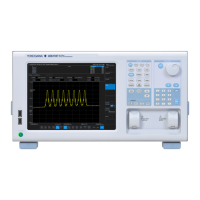2-4
IM AQ6370E-02EN
2.3 Waveform Display
Trace (Details chapter 4 in IM AQ6370E-01EN)
Display Function
This instrument has seven independent traces in which measured waveforms and calculated
waveforms are drawn.
For each trace, you can turn the waveform display on and off as well as set the trace to write mode
or calculation mode.
Write mode is further divided into (1) MAX/MIN HOLD mode, which detects and writes the
maximum and minimum values of each sweep, (2) roll average (sweep average) mode, which
takes a cumulative average for each sweep and writes the result, and (3) FIX mode in which no
writing takes place.
In calculation mode, calculated results such as calculation between traces, normalization of
waveforms, and approximation (curve fitting) of waveforms can be displayed in another trace.
Marker and Search
Marker (Details chapter 5 in IM AQ6370E-01EN)
Themarkerfunctionisusedtoplacethemovingmarker(▼)onadisplayedwaveformandshow
the wavelength and level at the marker position.
The function can be used to easily search for peak wavelengths and peak levels. Further, by setting
up to 1024 fixed markers, you can measure the wavelength difference or level difference between
adjacent fixed markers and between the moving marker and a fixed marker. In addition, markers
can be placed to display the power value per normalization bandwidth (power spectral density) and
integrated power of a specified range.
In addition to the normal marker, there are two vertical and horizontal line markers (wavelength line
marker and level line marker).
Wavelength line markers show wavelengths and wavelength difference while level line markers
show levels and level difference. Line markers can be used to specify a sweep range or analysis
range.
Search (Details section 4.9 in IM AQ6370E-01EN)
The peak/bottom search function can be used to detect waveform peak levels and bottom levels.
The function has two search modes: single, in which a single peak or a single bottom of the
measured waveform's level are detected, and multi, in which multiple peaks and bottoms are
detected in a single search.
Markers are displayed at the peak and bottom points.
There is also an auto search function that automatically performs peak/bottom searches during
each sweep. This is useful when you want to observe the changes to the peak and bottom levels
during repeat sweeping.

